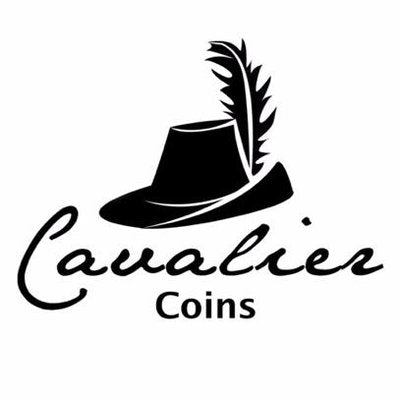Yes, some £1 coins can be worth a whole lot more than a quid, but it's important to know that this only applies to a select few. The vast majority of pound coins rattling around in your pocket or down the back of the sofa are worth exactly what they say they are: one pound.
So, what separates the treasure from the everyday tender? It all comes down to rarity, specific designs, and the coin's overall condition.
Understanding Your £1 Coin's True Value
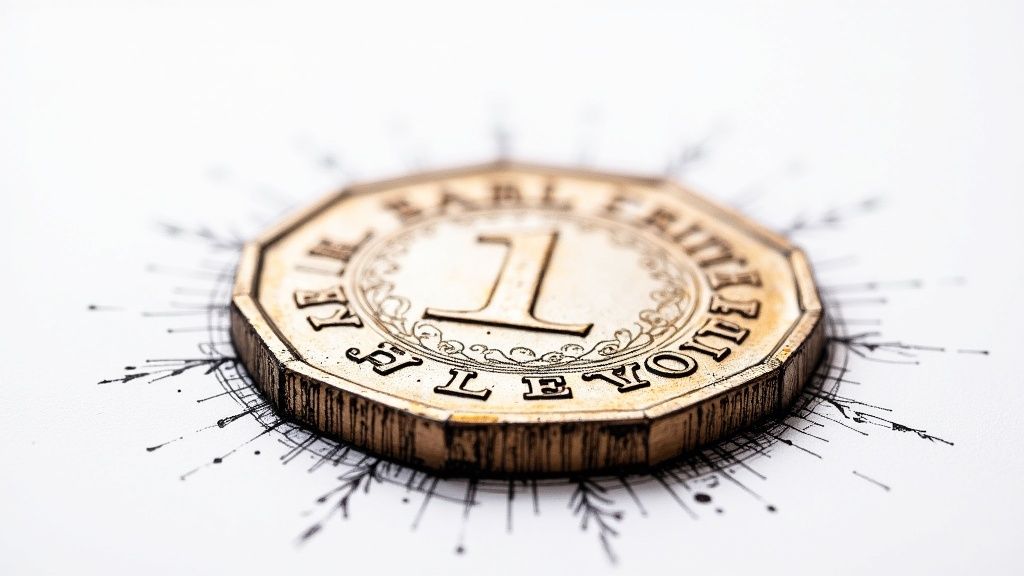
It’s easy to see a £1 coin as just spending money, but doing so overlooks the crucial distinction collectors make between face value and numismatic value.
Face value is straightforward—it’s the monetary worth stamped on the coin, the £1 you can use in any shop. Simple.
Numismatic value, on the other hand, is what an enthusiast or collector is actually willing to pay for it. Think of it like a classic car. Any old motor will get you from A to B, but a rare, beautifully preserved vintage model holds a much higher value for those in the know. The same principle applies to coins.
The historical and economic value of the £1 coin in the UK is closely linked to both its face value and its numismatic worth, which can fluctuate based on rarity, condition, and collector demand. The withdrawal of the round pound from circulation and its replacement with the 12-sided version has accentuated the old coins’ rarity, enhancing their appeal. You can dive deeper into the story of the £1 coin over at Change Checker.
Face Value vs Collector Value At a Glance
Here’s a quick breakdown to help you see the difference at a glance:
| Attribute | Face Value (£1) | Collector (Numismatic) Value |
|---|---|---|
| Source of Value | Stamped on the coin by The Royal Mint. | Determined by market demand from collectors. |
| Purpose | Everyday transactions and spending. | Collecting, investing, or historical appreciation. |
| Factors Affecting It | Fixed at one pound. | Rarity, condition, errors, and specific design. |
| Typical Worth | Always £1. | Can range from a few quid to hundreds of pounds. |
Essentially, while every £1 coin has a guaranteed face value, only a special few have that extra collector appeal that drives their price up.
Key Factors That Increase Value
So, what exactly elevates a standard pound coin into a sought-after collectible? A few key elements come into play, turning an ordinary piece of change into something far more desirable.
- Low Mintage Figures: This is simply how many of a particular coin design were produced by The Royal Mint. The fewer coins that were struck and released, the rarer they automatically become.
- Specific Designs: Certain commemorative designs are highly prized, especially some from the older round pound series which featured everything from capital cities to floral emblems.
- Condition: This one’s a biggie. A coin that looks like it just left the mint—with sharp details and no scratches—will always command a higher price than a heavily worn one that’s been through the wars.
The Story Behind the Pound Coin
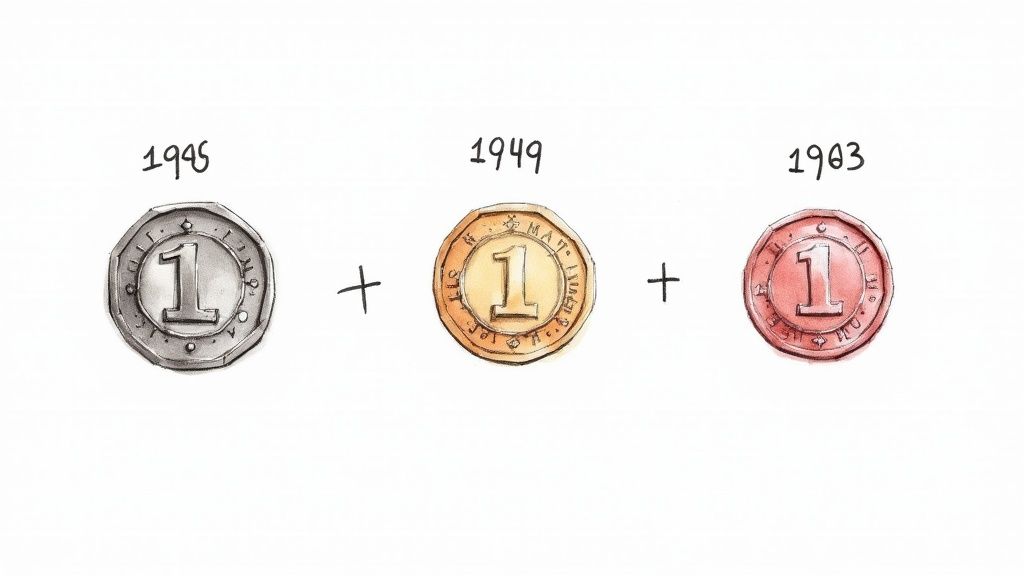
To really get a feel for a coin's potential value, you first need to know its story. The journey of the modern £1 coin kicked off back in 1983 with the debut of the now-iconic 'round pound'. For over thirty years, this coin was a familiar sight in British pockets, featuring a rotating series of designs celebrating the home nations.
But the round pound had a crucial weakness. Its simple, single-metal design made it a sitting duck for counterfeiters. By the 2010s, it was estimated that a staggering 1 in 30 round pounds in circulation were fakes. That's a statistic that seriously undermines public trust and pushed The Royal Mint to take drastic action.
What followed was one of the biggest currency shake-ups in a generation: the introduction of the 12-sided £1 coin in 2017.
A New Era of Coin Security
This wasn't just a simple change of shape. The new coin was engineered from the ground up to be the most secure circulating coin in the world, packed with clever features to outsmart the forgers.
- Bi-metallic Composition: The coin is made of two different metals—an outer gold-coloured nickel-brass ring and an inner silver-coloured cupro-nickel disc. This two-part construction is far trickier to replicate convincingly.
- Latent Image: It has a clever hologram-like image that changes from a '£' symbol to the number '1' when you tilt it in the light.
- Hidden Security Feature: There’s also a secret high-security feature built right into the coin itself, adding yet another layer of protection that counterfeiters can't see.
The original round £1 coins, issued from 1983 to 2016, were made of nickel-brass and measured 22.5mm across. The switch to the larger, bi-metallic 12-sided design was a direct, calculated response to the forgery problem, making the new version incredibly secure. For a deeper dive into the technical specs, the Check Your Change website is a great resource.
This transition effectively drew a line under the era of the round pound, instantly turning them into a finite piece of history for collectors. It's a bit like what happened with the 50p coin; this history is exactly what fuels the numismatic appeal for certain designs. You can read more about that in our guide on the colourful history of the British 50p coin.
Spotting the Most Valuable £1 Coins
Right, this is where the fun really starts. We're about to turn you from someone who just glances at their change into a proper treasure hunter. The real secret to finding a valuable £1 coin is knowing exactly which designs collectors are desperate to get their hands on, especially from the old round pound series that's now retired. Their limited numbers make them top targets.
A coin's value almost always comes down to its mintage figures. That’s just a fancy way of saying how many of a particular coin The Royal Mint ever made. The lower the mintage, the rarer the coin, and the more it could be worth. It’s classic supply and demand – with millions of collectors chasing a small number of coins, the scarcest ones naturally become the most valuable.
Identifying the Rarest Round Pounds
While most round pounds were minted in their tens of millions, a handful were produced in much smaller batches, which instantly makes them more interesting to collectors. If you spot designs like the 2011 Cardiff City coin or the 2014 Royal Arms issue, they're always worth a closer look.
But there’s one that really stands out from the crowd. The 2011 Edinburgh £1 coin, part of the series celebrating the UK's capital cities, had a mintage of just 935,000. It’s the only round £1 coin with a mintage below one million, making it a superstar in the collecting world. It's not uncommon to see them sell for more than ten times their face value.
The image below gives you a great visual idea of how a coin's rarity and condition can affect its value.
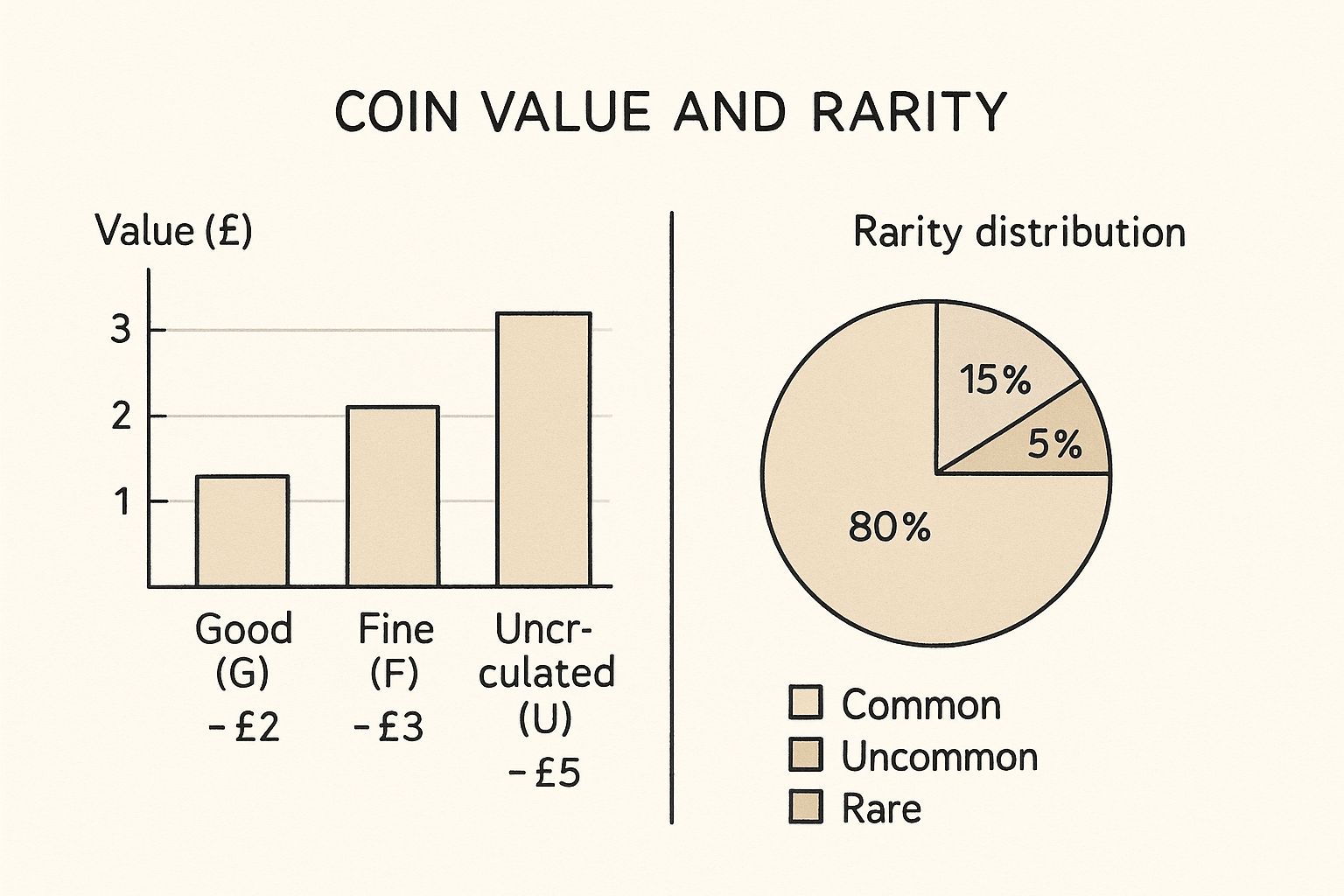
As you can see, even common coins become more valuable in better condition, but it's that tiny slice of genuinely rare coins that really gets collectors excited.
To give you a clearer picture, here are some of the most sought-after round £1 coins, ranked by how few were made.
Top 5 Collectible Round £1 Coins by Mintage
Many collectors focus on the round pounds with the lowest mintage figures. These coins were already relatively scarce when they were in circulation, and now that they've been withdrawn, they are becoming increasingly difficult to find.
| Coin Design | Year of Issue | Mintage Figure | Reason for Rarity |
|---|---|---|---|
| Edinburgh City | 2011 | 935,000 | The only round £1 with a mintage under one million. |
| Cardiff City | 2011 | 1,615,000 | The second-rarest in the popular 'Capital Cities' series. |
| London City | 2010 | 2,635,000 | Lower than average mintage for the first coin in its series. |
| Thistle & Bluebell | 2014 | 5,185,000 | Part of the final 'Floral Emblems' series before the new coin. |
| Crown & Diadem | 2015 | Not Circulated | Released only in special sets, never for general circulation. |
Finding any of these in your change would be a fantastic discovery, especially the Edinburgh City coin.
And remember, rarity isn't just about low mintage numbers. Minting errors, where a coin is struck incorrectly, can create exceptionally valuable and unique pieces. They are much, much harder to find, but the reward can be incredible.
These rare designs are just scratching the surface of what makes coin collecting so addictive. To expand your search, have a look at our guide on the 7 rare UK coins every collector should know. Once you know what to look for, you'll start sifting through your change with a whole new perspective.
Why a Coin's Condition Is Crucial
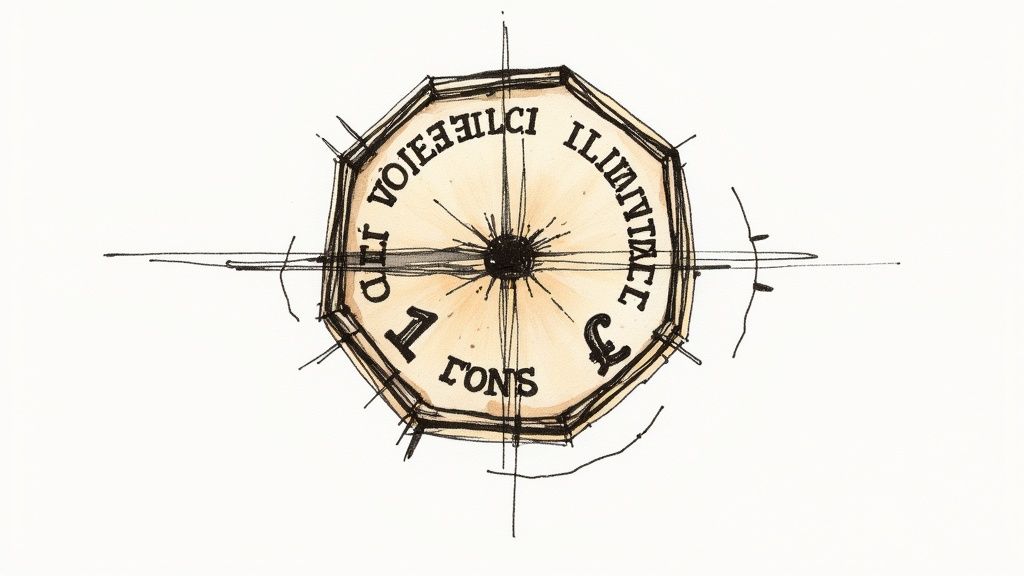
Finding a rare design in your change is a fantastic feeling, but that’s really only half the story. The physical state of a coin, what collectors call its grade, plays a massive part in what it’s actually worth. A rare coin that's badly scratched up and dull might only fetch a fraction of what an identical one in perfect condition could.
It's a bit like collecting vintage comics. A copy with crisp, colourful pages is a collector's dream, but one with creases, tears, and a faded cover is far less exciting. The same exact logic applies to your 1 pound coin value – even small dinks and scratches can make a huge difference to its price tag.
From Pocket Change to Perfect Specimen
To get a handle on a coin's condition, collectors use a grading scale. While it can get incredibly technical at the top end, most coins you'll come across will fit into a few simple categories. Getting to know them will help you figure out what you've really got.
Here are the main grades you’re likely to see:
- Circulated: This is the state of pretty much every coin in your wallet. They've been knocked about a bit, showing obvious signs of wear like softened details, little scratches, and a general lack of that fresh-from-the-mint shine.
- Brilliant Uncirculated (BU): This is the holy grail. A BU coin looks like it was just struck at The Royal Mint yesterday. It has razor-sharp details, a beautiful lustre, and no marks from being handled or dropped.
For a serious collector, the difference between a circulated coin and a Brilliant Uncirculated one is night and day. A BU coin is a perfect snapshot of the artist's original design, untouched by the outside world, which is why it commands a premium price.
So, how do you spot a top-grade coin? Look for its original mint lustre – that's the unique cartwheel-like shine you see when you tilt it in the light. Check that the edges of the letters are sharp and the fine details in the design haven't been worn smooth. The fewer nicks and marks, the better its grade and the higher its potential value.
How to Value and Sell Your Pound Coins
So, you think you’ve got a rare £1 coin sitting in your change jar? Brilliant. The next step is figuring out what it’s actually worth, and this is where you need to be a bit of a detective. It’s easy to get carried away by news articles or eBay listings with eye-watering prices, but those are often just wishful thinking.
The real secret lies in looking at what people have actually paid for a coin. The best place for this is the sold listings on eBay. This is hard data, not just hopeful guesswork. It shows you the true market value for a specific coin in a similar condition to yours, which is the only price that really matters.
Finding Current Market Prices
To get a solid valuation, you need to pull information from a few different places. This helps you build a complete picture of your 1 pound coin value and stops you from relying on a single, potentially biased source.
- Established Coin Dealers: Many professional numismatists have websites with price guides or catalogues. These are great for getting a ballpark figure from the experts.
- The Royal Mint: While they won’t give you a price for a coin you found in your pocket, their website is a goldmine for official details like mintage figures. This is your starting point for rarity.
- Auction Sold Listings: As I mentioned, this is your most powerful tool. On sites like eBay, make sure you filter your search by "Sold Items" to see the real-world prices people are currently paying.
The screenshot below from The Royal Mint’s website shows the exact kind of specifications you can find for different £1 coin designs.
This data, especially the mintage number, is the bedrock for working out how rare a coin is and what it might be worth. If you want to dive deeper, our guide on how to value old coins offers expert tips for collectors and is packed with useful information.
Preparing Your Coin for Sale
When it’s time to sell, presentation is everything. You absolutely have to take clear, well-lit photos. Put the coin on a plain, neutral background and get sharp, focused pictures of both the obverse (the Queen's head) and the reverse (the design). This gives potential buyers the confidence to properly assess its condition.
Crucial Tip: Whatever you do, never clean your coins. It’s the biggest mistake you can make. Cleaning leaves tiny scratches and strips away the natural patina that collectors prize, which can completely destroy its value. Sell it exactly as you found it.
As for where to sell, you have a couple of options. Online marketplaces give you a massive audience but be mindful of the fees. Selling directly to a professional dealer is often faster and much simpler, although you might get a slightly lower price for the convenience.
Common Questions About £1 Coin Value
Once you start seriously checking your change, the questions always start to pile up. To give you a head start, I've put together some of the most common queries people have about their £1 coin value, with straightforward answers to cut through the noise.
Think of this as your go-to reference sheet. It tackles the practical stuff, like what to do with old round pounds, the hard truth about cleaning, and what really makes a coin rare.
Can I Still Use the Old Round Pounds?
In short, no. You can’t spend them in shops anymore. The old round £1 coin was officially taken out of circulation on 15 October 2017, which means it's no longer considered legal tender.
But that absolutely does not mean they’re worthless. Most high street banks will still let you deposit them into your account. More importantly, their true potential now lies entirely in their numismatic value. For collectors, these coins are a finite piece of history, and the rare ones are worth far more than their original pound.
What Is the Rarest £1 Coin?
The undisputed champion of rarity among the old round pounds is the 2011 Edinburgh City coin. With a mintage of just 935,000, it's the only circulating round £1 coin that ever dipped below the one million mark.
This scarcity makes it the holy grail for many collectors. Its low production numbers meant finding one was always tough, but now that they're no longer in circulation, it's a real challenge. That difficulty only cranks up its desirability and value.
A quick tip for treasure hunters: always check the date and design of any round pound you come across. While the Edinburgh coin is the rarest, others like the 2011 Cardiff City and 2010 London City coins also have low mintage figures and are highly collectible.
Are Any 12-Sided £1 Coins Valuable?
For the most part, the new 12-sided £1 coins are only worth their face value of one pound. Millions are minted every single year, so they're incredibly common.
However, there are a couple of very specific exceptions to look out for. A tiny number of trial coins dated 2016 (a year before the official launch) slipped into circulation, and these can be valuable. You should also keep an eye out for minting errors—things like missing details, misaligned strikes, or even coins made from the wrong metals. These production slip-ups are extremely rare, but they can turn an ordinary coin into a highly sought-after prize.
Does Cleaning a Coin Increase Its Value?
This is a critical point for any aspiring collector, and the answer is an emphatic NO. You should never, ever clean a collectible coin.
Cleaning a coin, no matter how gently, creates microscopic scratches and abrasions on its surface. It also strips away the coin’s original lustre and patina—that thin layer of toning that develops over time. Collectors prize this natural ageing as proof of a coin's authenticity and history. Wiping it away can slash a coin's value by more than half, turning a potential treasure into just a shiny piece of metal.
Now that we’ve covered some of the most pressing questions, let’s consolidate them into a quick-reference table.
Common Questions and Quick Answers
Your go-to guide for quick answers on pound coin values.
| Question | Answer |
|---|---|
| Are the old round £1 coins still worth anything? | Yes, while you can no longer spend them in shops, you can deposit them at most UK banks. However, their true potential lies in their collector value. Rare designs or coins in exceptional condition can be worth significantly more than £1 to a numismatist. |
| Which £1 coin is the rarest? | The 2011 Edinburgh City round pound is the rarest £1 coin intended for circulation, with a mintage of just 935,000. This low production number makes it highly sought after by collectors. |
| How can I tell if my 12-sided £1 coin is valuable? | Most 12-sided £1 coins are worth their face value. However, some early releases from 2016 (before the official 2017 launch) and coins with minting errors (like misaligned strikes or incorrect metals) can be valuable. These are extremely rare but worth looking out for. |
| Does cleaning a coin increase its value? | Absolutely not. In fact, cleaning a collectible coin almost always decreases its value significantly. Cleaning can cause microscopic scratches and remove the original patina, which collectors value highly. It's best to leave coins as you find them. |
Hopefully, this FAQ clears up some of the most common points of confusion and helps you on your collecting journey.
At Cavalier Coins Ltd, we provide a trusted marketplace for both seasoned numismatists and new collectors to discover rare and valuable pieces. Explore our curated collection of coins from around the world.
